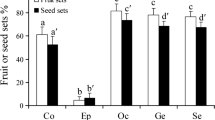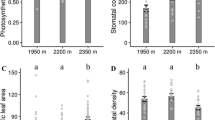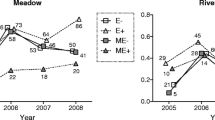Abstract
The extent to which local biotic factors like herbivory and pollination affect mode of reproduction in plants is not yet fully understood. Mode of reproduction is ecologically important because it can influence the spread and distribution of plant populations through factors like offspring dispersal distance and establishment success. The two experiments described here address the potential effects of damage and pollen receipt on plant growth, sexual reproduction, and asexual reproduction in a clonal flowering plant (Eichhornia crassipes, water hyacinth). These experiments were conducted in greenhouse and outdoor tanks at the Florida State University research facilities in Tallahassee, FL, on plants collected from north Florida populations. Plants received manual damage to leaves (imposing a loss of resources), apical meristems (imposing a loss of leaf and flower production), or axillary meristems (imposing a loss of clone production). Apical meristem damage increased asexual reproduction (clone number). When severe, axillary meristem damage increased plant growth (leaf production). Neither leaf damage nor pollination affected plant growth, clone production, or flower production. Asexual reproductive responses to damage have not been well studied, although sexual reproduction and individual plant growth have been shown to increase following damage. These results have implications for the dispersal and establishment of clonal plants in the presence of herbivory. For a highly invasive species like E. crassipes, these results can further inform the use of insect herbivores to manage invasive populations.





Similar content being viewed by others
References
Bai W, Sun X, Wang Z, Li L (2009) Nitrogen addition and rhizome severing modify clonal growth and reproductive modes of Leymus chinensis population. Plant Ecol 205:13–21
Barrett S (1980) Sexual reproduction in Eichhornia crassipes (water hyacinth). 2. Seed production in natural populations. J Appl Ecol 17:113–124
Bates, DM (2010) lme4: Mixed-effect modeling with R. http://www.lme4.r-forge.r-project.org/book/
Bock JH (1969) Productivity of water hyacinth Eichhornia crassipes (Mart) Solms. Ecology 50:460–464
Boose A, Holt J (1999) Environmental effects on asexual reproduction in Arundo donax. Weed Res 39:117–127
Brathen KA, Junttila O (2006) Infertile times: response to damage in genets of the clonal sedge Carex bigelowii. Plant Ecol 187:83–95
Buchanan A (2013) Damage by Neochetina weevils (Coleoptera: Curculionidae) induces resistance in Eichhornia crassipes (Commelinales: Pontederiaceae). Fla Entomol 96(2):458–462
Center T, Van T (1989) Alteration of water hyacinth (Eichhornia crassipes (Mart) Solms) leaf dynamics and phytochemistry by insect damage and plant density. Aquat Bot 35:181–195
Center T, Dray F, Jubinsky G, Grodowitz M (1999a) Biological control of water hyacinth under conditions of maintenance management: can herbicides and insects be integrated? Environ Manag 23:241–256
Center T, Dray F, Jubinsky G, Leslie A (1999b) Water hyacinth weevils (Neochetina eichhorniae and N. bruchi) inhibit water hyacinth (Eichhornia crassipes) colony development. Biol Control 15:39–50
Center T, Van T, Dray F, Franks S, Rebelo M, Pratt P, Rayamajhi M (2005) Herbivory alters competitive interactions between two invasive aquatic plants. Biol Control 33:173–185
Cilliers C (1991) Biological control of water hyacinth, Eichhornia crassipes (Pontederiaceae), in South-Africa. Agric Ecosyst Environ 37:207–217
Clark MJ, Husband BC (2007) Plasticity and timing of flower closure in response to pollination in Chamerion angustifolium (Onagraceae). Int J Plant Sci 168:619–625
DeLoach C, Cordo H (1976) Life-cycle and biology of Neochetina bruchi, (Coleoptera-Curculionidae-Bagoini) a weevil attacking waterhyacinth in Argentina, with notes on Neochetina eichhorniae. Ann Entomol Soc Am 69:643–652
Diezel C, Kessler D, Baldwin IT (2011) Pithy protection: nicotiana attenuata’s jasmonic acid-mediated defenses are required to resist stem-boring weevil larvae. Plant Physiol 155:1936–1946
Elle E, Hare JD (2002) Environmentally induced variation in floral traits affects the mating system in Datura wrightii. Funct Ecol 16:79–88
Eriksson O (1997) Clonal life histories and the evolution of seed recruitment. de Kroon H and Van Groenendael JM (eds) The ecology and evolution of clonal plants. Backhhuys Publishers, Leiden, pp 211–226
Geber M, Watson M, Furnish R (1992) Genetic differences in clonal demography in Eichhornia crassipes. J Ecol 80:329–341
Harder L, Johnson S (2005) Adaptive plasticity of floral display size in animal-pollinated plants. Proc R Soc Lond Ser B-Biol Sci 272:2651–2657
Herrera I, Nassar JM (2009) Reproductive and recruitment traits as indicators of the invasive potential of Kalanchoe daigremontiana (Crassulaceae) and Stapelia gigantea (Apocynaceae) in a Neotropical arid zone. J Arid Environ 73:978–986
Ladio AH, Aizen MA (1999) Early reproductive failure increases nectar production and pollination success of late flowers in south Andean Alstroemeria aurea. Oecologia 120:235–241
Lehtilä K, Strauss SY (1997) Leaf damage by herbivores affects attractiveness to pollinators in wild radish, Raphanus raphanistrum. Oecologia 111:396–403
Meyer G, Root R (1993) Effects of herbivorous insects and soil fertility on reproduction of goldenrod. Ecology 74:1117–1128
Moran P (2005) Leaf scarring by the weevils Neochetina eichhorniae and N. bruchi enhances infection by the fungus Cercospora piaropi on water hyacinth Eichhornia crassipes. Biocontrol 50:511–524
Obeso JR (2002) The costs of reproduction in plants. New Phytol 155:321–348
Paige KN, Whitham TG (1987a) Flexible life history traits: shifts by scarlet gilia in response to pollinator abundance. Ecology 68(6):1691–1695
Paige KN, Whitham TG (1987b) Overcompensation in response to mammalian herbivory: the 340 advantage of being eaten. Am Nat 129:407–416
Penfound W, Earle T (1948) The biology of the water hyacinth. Ecol Monogr 18:447–472
Pilson D, Decker K (2002) Compensation for herbivory in wild sunflower: response to simulated damage by the head-clipping weevil. Ecology 83:3097–3107
Pinheiro J, Bates D, DebRoy S, Sarkar D (2011) Nlme: linear and nonlinear mixed effects models, R package version 3.1-102
Quesada M, Bollman K, Stephenson AG (1995) Leaf damage decreases pollen production and hinders pollen performance in Cucurbita texana. Ecology 76:437–443
Ralph SG, Yueh H, Friedmann M, Aeschliman D, Zeznik JA, Nelson CC, Butterfield YSN, Kirkpatrick R, Liu J, Jones SJM, Marra MA, Douglas CJ, Ritland K, Bohlmann J (2006) Conifer defence against insects: microarray gene expression profiling of Sitka spruce (Picea sitchensis) induced by mechanical wounding or feeding by spruce budworms (Choristoneura occidentalis) or white pine weevils (Pissodes strobi) reveals large-scale changes of the host transcriptome. Plant Cell Environ 29:1545–1570
Snow A, Whigham D (1989) Costs of flower and fruit production in Tipularia discolor (Orchidaceae). Ecology 70:1286–1293
Stark J, Goyer R (1983) Life-cycle and behavior of Neochetina eichhorniae Warner (Coleoptera, Curculionidae) in Louisiana: a biological-control agent of waterhyacinth. Environ Entomol 12:147–150
Steets JA, Ashman TL (2004) Herbivory alters the expression of a mixed-mating system. Am J Bot 91:1046–1051
R Development Core Team 2011 R: a language and environment for statistical computing
Wise MJ, Abrahamson WG, Landis K (2006) Edaphic environment, gall midges, and goldenrod clonal expansion in a mid-successional old-field. Acta Oecol-Int J Ecol 30:365–373
Zhang Y, Zhang D, Barrett SCH (2010) Genetic uniformity characterizes the invasive spread of water hyacinth (Eichhornia crassipes), a clonal aquatic plant. Mol Ecol 19:1774–1786
Zuur AF, Ieno EN, Walker NJ, Saveliev AA, Smith GM (2009) Mixed Effects Models and Extensions in Ecology with R. Springer, NY
Acknowledgments
N. Underwood and B. Inouye provided invaluable comments and advice, D. McNutt assisted with field collections, and J. Travis furnished cattle tanks. Thanks also to the Underwood/Inouye, Gruner, and Hooks lab groups, as well as anonymous reviewers, for helpful comments. Funding was provided by the Florida Exotic Pest Plant Council Julia Morton Invasive Plant Research Grant. Invasive plant collection was allowed under DACS PI-208 permit number 2010–2017.
Author information
Authors and Affiliations
Corresponding author
Additional information
Communicated by Anne Bonis.
Electronic supplementary material
Below is the link to the electronic supplementary material.
Rights and permissions
About this article
Cite this article
Buchanan, A.L. Effects of damage and pollination on sexual and asexual reproduction in a flowering clonal plant. Plant Ecol 216, 273–282 (2015). https://doi.org/10.1007/s11258-014-0434-8
Received:
Accepted:
Published:
Issue Date:
DOI: https://doi.org/10.1007/s11258-014-0434-8




